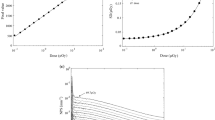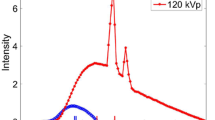Abstract
The optimum X-ray tube voltage for chest radiographic examinations remains unclear; hence, the tube voltage varies between medical facilities. An exposure index (EI) was proposed to standardize the parameters for radiographic examinations. However, even if identical EI values are used to examine the same person, organ doses may vary due to differences in tube voltages. In this study, the variation in organ doses between different beam qualities under identical EI values for chest radiographic examinations was investigated using Monte Carlo simulations. A focused anti-scatter grid as well as standard and larger physique-type medical internal radiation dose (MIRD) phantoms were studied under tube voltages of 90, 100, 110, and 120 kVp. The organ doses in the MIRD phantom increased as the X-ray tube voltage decreased, even with identical EI values. The absorbed doses in the lungs of standard and large-sized MIRD phantoms at 90 kVp were 23% and 35% higher than those at 120 kVp, respectively. The doses to organs other than the lung at 90 kVp were also higher than those at 120 kVp. From the perspective of reducing radiation doses, a tube voltage of 120 kVp is considered better for chest examinations compared with a tube voltage of 90 kVp under identical EI values.







Similar content being viewed by others
References
Kuwahara C, Aoki T, Oda N, Kawabata J, Sugimoto K, Kobayashi M, Fujii M, Korogi Y (2019) Optimal beam quality for chest flat panel detector system: realistic phantom study. Eur Radiol 29:4538–4543. https://doi.org/10.1007/s00330-019-5998-1
Kawashima H, Ichikawa K, Kunitomo H (2021) Relationship between radiation quality and image quality in digital chest radiography: validation study using human soft tissue-equivalent Phantom. Nihon Hoshasen Gijutsu Gakkai Zasshi 77(3):255–262. https://doi.org/10.6009/jjrt.2021_JSRT_77.3.255. (in Japanese)
Dobbins JT III, Samei E, Chots HG, Warp RJ, Baydush AH, Floyd CE Jr, Ravin CE (2003) Chest radiography: optimization of x-ray spectrum for cesium iodide-amorphous silicon flat-panel detector. Radiology 226:221–230. https://doi.org/10.1148/radiol.2261012023
Yasumatsu S, Tanaka N, Iwase K, Shimizu Y, Morishita J (2016) Effect of X-ray beam quality on determination of exposure index. Radiol Phys Technol 9:109–115. https://doi.org/10.1007/s12194-015-0340-3
Butler ML, Rainford L, Last J, Brennan PC (2010) Are exposure index values consistent in clinical practice? a multi-manufacturer investigation. Radiat Protect Dosi 139(1):371–374. https://doi.org/10.1093/rpd/ncq094
Baker M (2012) Investigation into factors influencing Fuji S-value using an extremity Phantom. J Med Imaging Radiat Sci 43(1):34–37. https://doi.org/10.1016/j.jmir.2011.08.002
IEC 62494-1 (2008) 1.0. Medical electrical equipment—exposure index of digital X-ray imaging systems—part 1: definition and requirements for general radiography. International Electrotechnical Commission, Geneva
Kyriakou I, Emfietzoglou D, Ivanchenko V et al (2017) Microdosimetry of electrons in liquid water using the low-energy models of Geant4. J Appl Phys 122:024303. https://doi.org/10.1063/1.4992076
Snyder WS, Ford MR, Warner GG (1969) MIRD pamphlet No. 5 revised: estimates of absorbed fractions for monoenergetic photon sources uniformly distributed in various organs of a heterogeneous phantom. J Nucl Med Suppl 3:5–52
ICRP Publication 23 (1975) Report of the task group on Reference Man. Annals of the ICRP/ICRP Publication 23. Pergamon Press, Oxford
Guatelli S, Mascialino B, Pia MG, Pokorski W (2006) Geant4 antropomorphic phantoms. IEEE Nuclear Science Symposium Conference Record 3:1359–1362. https://doi.org/10.1109/NSSMIC.2006.354155
Syahir MK, Fahmi MR, Hashikin NAA (2020) Dosimetric comparison between different radiotherapy protocols for prostate cancer using Geant4 Monte Carlo simulation. J Phys: Conf Ser 1497:012018. https://doi.org/10.1088/1742-6596/1497/1/012018
Laboratory of Radiological Technology (n.d.) https://hidekikato1952.wixsite.com/radiotechnology. Accessed Octorber 23, 2021
Shoji T (2021) Basics of radiation exposure in X-ray CT. Nihon Hoshasen Gijutsu Gakkai Zasshi 77(10):1223–1230. https://doi.org/10.6009/jjrt.2021_JSRT_77.10.1223. (in Japanese)
Buchanan I, Mittone A, Bravin A, Diemoz P, Endrizzi M, Olivo A (2020) Simplified retrieval method for edge illumination X-ray phase contrast imaging allowing multi-modal imaging with fewer input frames. Opt Express 28:11597–11608. https://doi.org/10.1364/OE.372312
Yoon Y, Park H, Kim J, Kim J, Roh Y, Tanaka N, Morishita J (2021) Proper management of the clinical exposure index based on body thickness using dose optimization tools in digital chest radiography: a phantom study. Int J Environ Res Public Health 18:5203. https://doi.org/10.3390/ijerph18105203
Fukuda A, Matsubara K, Miyati T (2015) Long-term stability of beam quality and output of conventional x-ray. Units Radiol Phys Technol 8:26–29. https://doi.org/10.1007/s12194-014-0282-1
Ibaraki Association of Radiologic Technologists EPD (n.d.) http://www.iart-web.org/epd/. Accessed September 27, 2022
Tunga CJ, Lee CJ, Tsai HY, Tsai SF, Chen IJ (2008) Body size-dependent patient effective dose for diagnostic radiography. Radiat Meas 43:1008–1011. https://doi.org/10.1016/j.radmeas.2007.11.028
Ekpo EU, Hoban AC, McEntee MF (2014) Optimisation of direct digital chest radiography using Cu filtration. Radiography 20:346–350. https://doi.org/10.1016/j.radi.2014.07.001
Dave JK, Jones AK, Fisher R et al (2018) Current state of practice regarding digital radiography exposure indicators and deviation indices: report of AAPM Imaging Physics Committee Task Group 232. Med Phys 45(11):e1146–e1160. https://doi.org/10.1002/mp.13212
Menzel HG, Clement C, DeLuca P (2009) Realistic reference phantoms: an ICRP/ICRU joint effort. A report of adult reference computational phantoms. Ann ICRP 39(2):1–164. https://doi.org/10.1016/j.icrp.2009.09.001
Sng LH, Arlany L, Toh LC, Loo TY, Ilzam NS, Wong BSS, Lanca L (2021) Initial data from an experiment to implement a safe procedure to perform PA erect chest radiographs for COVID-19 patients with a mobile radiographic system in a ‘clean’ zone of the hospital ward. Radiography 27:48–53. https://doi.org/10.1016/j.radi.2020.05.011
Acknowledgements
I would like to thank Editage (www.editage.com) for English language editing. I also thank Ibaraki Association of Radiologic Technologists for providing the “EPD” software.
Funding
No funding was received for conducting this study.
Author information
Authors and Affiliations
Corresponding author
Ethics declarations
Conflict of interest
The author has no conflict of interest.
Ethical approval
This article does not contain any studies with human participants or animals performed by any of the authors.
Additional information
Publisher’s Note
Springer Nature remains neutral with regard to jurisdictional claims in published maps and institutional affiliations.
Rights and permissions
Springer Nature or its licensor (e.g. a society or other partner) holds exclusive rights to this article under a publishing agreement with the author(s) or other rightsholder(s); author self-archiving of the accepted manuscript version of this article is solely governed by the terms of such publishing agreement and applicable law.
About this article
Cite this article
Nakanishi, K. Comparison of organ dose from chest radiography with varying beam quality and constant exposure index. Phys Eng Sci Med 46, 1143–1151 (2023). https://doi.org/10.1007/s13246-023-01281-0
Received:
Accepted:
Published:
Issue Date:
DOI: https://doi.org/10.1007/s13246-023-01281-0




